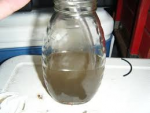Hey, I am at my wits end here
I changed the front brake line on my GS500. I drained the system, pulled the old line, put the new one on, and filled it up while getting the air out of the lines. I got to the point where I wasn't seeing any air bubbles come out of the bleed line, the lever felt good, so I closed it all up, and it was fine, went for a ride and everything.
The next day I saw some brake fluid out around the reservoir cap, so I pulled the cap off and cleaned it up, made sure everything was in order, put it back on. I also noticed the brakes were a little spongy. I zip-tied the front brake lever to the throttle overnight, which has helped in the past to remove the sponginess when I bled the lines
Few days later, some fluid around the top of the reservoir again, brakes still spongy. So I cleaned it up and zip-tied again. Over and over, probably 3-4 cycles now. There is no fluid leaking from the brake line connections at the reservoir or caliper, and the reservoir is still at the same level pretty much.
Any suggestions? The sponginess means there is air in the system, right? It seems to be getting worse with use or time, I am not sure which one.
Is it just all **** because I started from an empty line and don't have a vacuum pump? Do I just need to bleed it more?
To make matters worse, my bleed nipple is in bad shape, the 8mm wrench rounds it out and the 7mm is too small. This is why I haven't tried to re-bleed it, because the parts websites are saying it will be 3-4 weeks and $50 in shipping to send a new $7 bleed nipple
I am so confused at everything
I changed the front brake line on my GS500. I drained the system, pulled the old line, put the new one on, and filled it up while getting the air out of the lines. I got to the point where I wasn't seeing any air bubbles come out of the bleed line, the lever felt good, so I closed it all up, and it was fine, went for a ride and everything.
The next day I saw some brake fluid out around the reservoir cap, so I pulled the cap off and cleaned it up, made sure everything was in order, put it back on. I also noticed the brakes were a little spongy. I zip-tied the front brake lever to the throttle overnight, which has helped in the past to remove the sponginess when I bled the lines
Few days later, some fluid around the top of the reservoir again, brakes still spongy. So I cleaned it up and zip-tied again. Over and over, probably 3-4 cycles now. There is no fluid leaking from the brake line connections at the reservoir or caliper, and the reservoir is still at the same level pretty much.
Any suggestions? The sponginess means there is air in the system, right? It seems to be getting worse with use or time, I am not sure which one.
Is it just all **** because I started from an empty line and don't have a vacuum pump? Do I just need to bleed it more?
To make matters worse, my bleed nipple is in bad shape, the 8mm wrench rounds it out and the 7mm is too small. This is why I haven't tried to re-bleed it, because the parts websites are saying it will be 3-4 weeks and $50 in shipping to send a new $7 bleed nipple
I am so confused at everything


